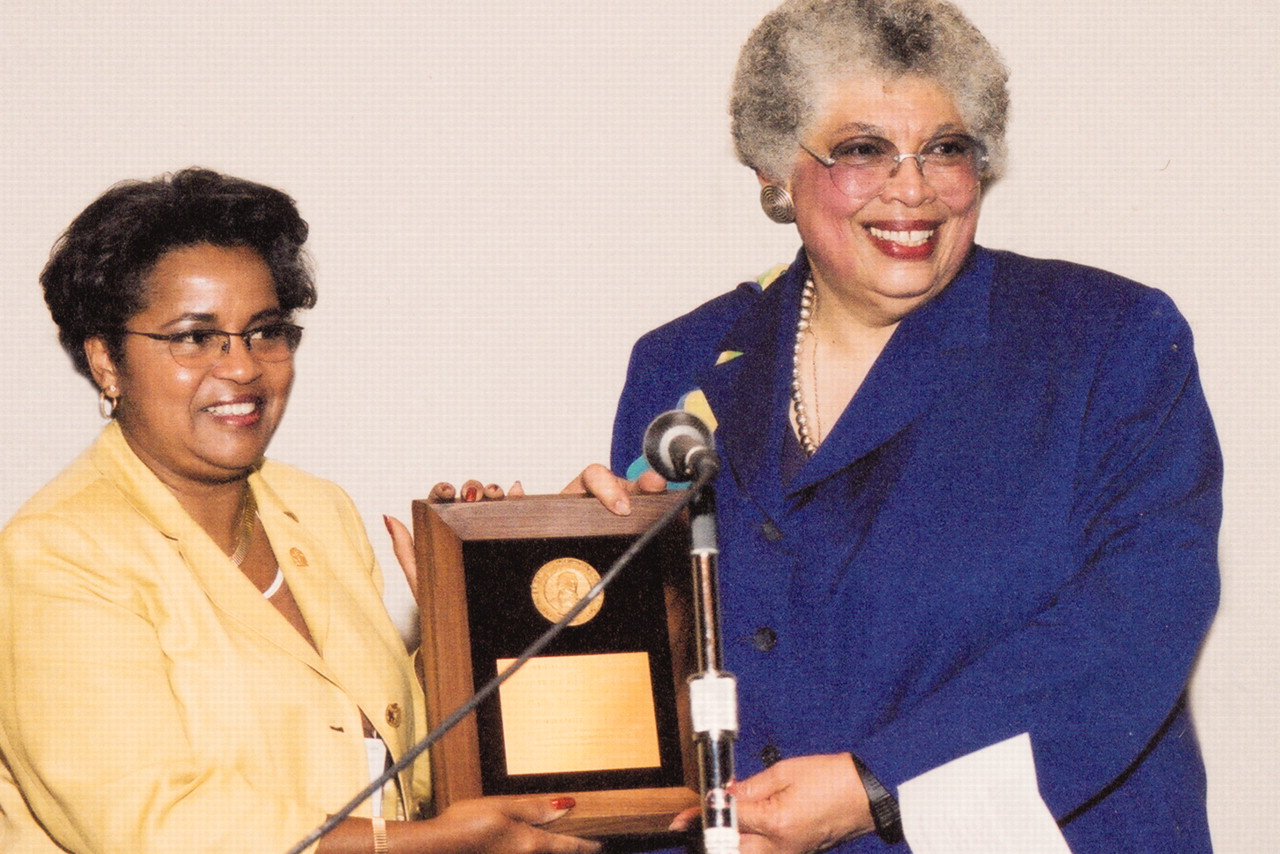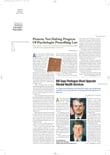Telepsychiatry has the power to bridge distances between psychiatrists and patients everywhere, and especially between the relatively few black psychiatrists and the many African-American patients who need their help.
So said Phyllis Harrison-Ross, M.D., in a lecture at APA's annual meeting in New York City last month. Harrison-Ross received the 2004 Solomon Carter Fuller Award for lifetime achievement. The award honors an individual who has“ pioneered in an area which has benefited significantly the quality of life for black people.”
Drawing on personal anecdotes and case histories, Harrison-Ross issued a compelling call for psychiatrists—especially black psychiatrists—to use the new technology of modem and digital videoconferencing to expand the reach of public and community psychiatry to underserved patients.
“With a computer and a camera, patients and their psychiatrists can see and talk to one another through telepsychiatry,” she said.
Noting that only 2 percent of the nation's psychiatrists are African American, she added that “telepsychiatry can make psychiatrists available to people in prisons, people who are housebound, armed services personnel on ships, seniors in nursing homes, teenagers who are uncomfortable in a psychiatrist's office, and black people who need an African-American psychiatrist in places where there are none.”
Harrison-Ross is the founder and managing partner of the Black Psychiatrists of Greater New York and Associates and the Emerita Professor of Psychiatry and Behavioral Health Sciences at New York Medical College.
Refuting Fictions With Facts
In her address, titled “I Am a Fact, Not a Fiction,” Harrison-Ross contrasted a host of facts with what she called the fictions they are meant to refute—including the fiction that seeing a patient in an office is the only way to help the patient on an outpatient basis.
“The fact is, in this day and age, there are many who need our services and can get them only over a cable or modem,” she said.“ We must not turn our backs on them, and we cannot allow ourselves to be intimidated by the technology. The need for psychiatry in our communities is great.”
Harrison-Ross said she began using telepsychiatry in the treatment of a patient whose work required him to travel frequently. “I was treating him individually and in family sessions with his families from several marriages,” she said. “He wanted to continue individual and family sessions when he was out of the country, no matter where he was in the world.”
“It was immediately evident that as a rare African-American psychiatrist, I could use this new technology to make myself available for African Americans anywhere who would trust only an African-American physician,” she said. “It also gave me the means to be available to physicians from other cultures who wanted to have a consultation or supervision session around one of their patients who happened to be African American.”
Treating Across Racial and Cultural Lines
Harrison-Ross recalled the immediate aftermath of the terrorist attacks in New York City on September 11, 2001, when teleconferencing allowed agencies in the city to consult with each other while phone service was dead. She recounted the case of another patient with a broken leg, unable to leave her home, who benefited from telepsychiatry.
But she especially emphasized the benefits of telepsychiatry for black and other minority patients who may not have access to the culturally sensitive care they require.
“I don't believe that every black patient must have a black psychiatrist,” she said. “But I do believe that there are very good reasons why the mental health needs of some black people can be addressed only by black psychiatrists.
“As our profession welcomes people from many countries and backgrounds, we must learn how to treat patients across racial and ethnic lines,” she said. “Patients with psychiatrists of different racial or ethnic backgrounds may need help in letting the psychiatrist know when they are experiencing communications problems. Telepsychiatry can be very helpful in these situations by providing the means for consultations with culturally sensitive psychiatrists who can help the patient or the psychiatrist face communications issues.”
Harrison-Ross drew special attention to the ways that teleconferencing could help reach the burgeoning numbers of mentally ill people in jails and prisons.
“Imagine what telepsychiatry means for prisoners' families,” she said. “Children need to maintain connection with their incarcerated parents. They need to see their fathers and mothers. They need to talk with their parents even if the parents are locked up. Plus, these children also need the support and guidance of therapists—therapists who can help them preserve the bonds with the parents, while breaking the behavioral cycle that makes going to prison a way of life.”
She reported that a total of about 70 psychiatric interviews using telepsychiatry have been conducted in prisons in New York State. The New York State Office of Mental Health and the Black Psychiatrists of Greater New York are undertaking a study of patient satisfaction with telepsychiatry, she said.
Don't Use One-Size-Fits-All Prescribing
In a broad defense of medical professionalism against incursions on practice by managed care—especially the use of preferred medication lists—Harrison-Ross argued that a “one-size-fits-all” approach to prescribing would damage many patients, especially minority patients.
She noted, for instance, that some research suggests that African Americans may metabolize drugs differently from the way in which white people do, requiring a more individualized approach to prescribing.
Much work remained to be done in combating the special stigma associated with mental illness—and treatment for mental illness—in the African-American community, said Harrison-Ross.
She recounted the case of an African-American woman who, upon being advised to start medication, responded, “Black people don't do medication.”
Another barrier is religious faith traditions within the African-American community that encourage the belief that prayer, and prayer alone, can heal disorder and disease. “The fact is,” she said, “no matter how hard we try, we can't pray our way out of some things.” ▪

